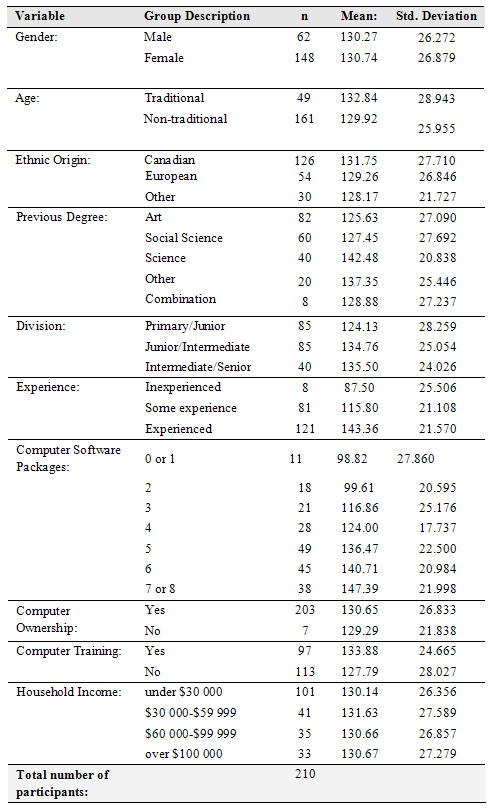
Authors
Jelena Magliaro is a PhD student at the University of Windsor. Her background in computer science and psychology has influenced her research interests, focussing on the role of educators in technology and teaching. Correspondence regarding this article can be sent to: jelena@uwindsor.ca
Anthony N. Ezeife is a Professor in the Faculty of Education, University of Windsor. He can be reached at: aezeife@uwindsor.ca
Abstract: For Canada to compete effectively in the digital world, beginning teachers need to play an important role in integrating computer technology into the curriculum. Equipment and connectivity do not guarantee successful or productive use of computers in the classroom, but the combination of the teaching style and technology use has the potential to change education. In this research, the computer self-efficacy beliefs of 210 preservice teachers after their first practice teaching placements were examined. First, the quantitative component of the study involved the use of Computer User Self-Efficacy (CUSE) scale where students’ previous undergraduate degree, licensure area, experience and familiarity with software packages were found to have statistically significant effects on computer self-efficacy. Second, the qualitative data indicated that society and school were the most positive factors that influenced preservice teachers’ attitudes towards computers, while the family had the highest percentage of negative influence. Findings reveal that although preservice teachers had completed only two months of the program, those with higher CUSE scores were more ready to integrate computers into their lessons than those with lower scores.
Résumé: Pour que le Canada puisse entrer en compétition dans le monde numérique, les nouveaux enseignants devront jouer un rôle important d’intégration des technologies informatiques dans le curriculum. Les équipements et la connectivité ne garantissent pas une utilisation gagnante ou productive de l’ordinateur en salle de classe, mais la combinaison de styles d’enseignement et d’usages de la technologie a le potentiel de changer l’éducation. Dans cette étude, les croyances d’auto-efficacité à l’ordinateur de 210 futurs enseignants après leur première affectation ont été examinées. Premièrement, la partie quantitative de l’étude impliquait l’utilisation de l’échelle du Computer User Self-efficacy (CUSE) qui a montré un effet statistiquement significatif des études de premier cycle des étudiants, du domaine dans lequel ils sont certifiés pour pratiquer, de l’expérience et de la familiarité avec des logiciels sur l’auto-efficacité avec les ordinateurs. Deuxièmement, les données qualitatives indiquent que la société et l’école sont les facteurs les plus positifs qui influencent l’attitude des futurs enseignants par rapport aux ordinateurs, alors que la famille a l’influence négative la plus forte. Les résultats ont montré que malgré le fait que les futurs enseignants n’avaient complété que deux mois de leur programme, ceux qui présentaient un score CUSE élevé étaient plus enclins à intégrer les ordinateurs dans leurs leçons que ceux qui avaient obtenu un score plus faible.
Computer technology is an omnipresent fact of life and education. We live in a fast-paced world where information is transferred on a daily basis. In this changing world, the teacher's role has shifted. Teachers are not only responsible for delivering content to their students, but must also develop new ways of learning. In order for new methods to be successful, the teaching profession has been challenged to develop new ways of teaching (Jacobsen, Clifford, & Friesen, 2002). Jacobsen, Clifford and Friesen noted the following: “For Canada to compete and excel in a global community, our young people need to develop the understandings, skills, and attributes that will serve them well in a knowledge era” (p.364).
The teacher’s role has a huge impact on educational technology. The way teachers view technology, how they respond to it, how they present it, and how it helps to accomplish their vision of teaching and learning, will affect future years of educational technology implementation (Roblyer, 2003). Some teacher education programs remain problematic due to the amount of time spent on examining technological potential. Many inservice (currently teaching) and preservice (currently in training) teachers believe that they are not adequately trained and often are not given appropriate tools to implement educational technology in their classrooms (Hardy, 2003). Furthermore, even though preservice teachers have formal training in instructional technology, most new teachers have limited knowledge about integrating computer technology into their professional practice and curriculum (Bauer, 2000; Hardy, 2003; Pellegrino & Altman, 1997). Thus, an increased amount of positive exposure to technology in all areas of academia may generate more favourable attitudes toward computers and educational technology.
“Self-efficacy can be defined as the beliefs a person has about their capabilities to successfully perform a particular behavior or task”(Cassidy & Eachus, 2002, p.134). In the formulation of a theoretical view for studying the computer self-efficacy of preservice teachers, Bandura’s social cognitive theory provides a useful model. Bandura (1986) postulated that behaviours were best understood in terms of “triadic reciprocal determinism”(p. 23), which was defined as a belief that cognition, behaviour and the environment operate interactively as determinants of one another. In other words, individuals did not simply react to environmental events; the individuals were able to actively create their own environments and act to change them. Thus, positive or negative feedback for behaviour, in turn, influenced people’s thinking (cognitions) and the ways in which they acted to change the environment (Bandura).
Bandura (1977, 1986, 1997) stated that the acquisition of different levels of self efficacy was determined by the following four major sources: (i) Performance accomplishments (success or failures)–where efficacy expectations were ingrained in personal mastery experiences. Higher expectations were created by successful experience, whereas in contrast, the low expectations were created by failure experiences. To change the low expectation one had to have a repeated and frequent success stimulated by individual determined effort; (ii) vicarious experiences (observing other people’s successes and failures)–seeing or visualizing other people performing successfully–could inspire high self-perceptions of efficacy in observers; (iii) verbal persuasion (from teachers, relatives, colleagues)–used as encouragement to let one know that he/she may have the necessary capabilities to accomplish the goal; and (iv) emotional arousal (affective state)–difficult situations caused a high state of arousal where one could use this arousal information to judge one’s capabilities. Therefore, strong feelings of self-efficacy in students can help them to create a better academic or occupational environment. Preservice teachers with lower computer self-efficacy are more likely to have problems with technology integration and are likely to have problems integrating technology into their own classroom when they complete teacher education programs and start teaching (Wall, 2004).
Preservice teachers are expected to be knowledgeable about current technology and how it can be used to promote learning. Many school leaders and inservice teachers look to new teachers to fill the gap between the technology available in schools and its effective integration into the curriculum (Jacobsen, Clifford & Friesen, 2002). Thus, preservice teachers’ strengths and weaknesses as they affect technology integration should be evaluated in order to determine their potential for the effective use of computers (Wall, 2004). The Computer User Self-Efficacy (CUSE) scale may be used to identify individuals, and in this study, preservice students, who will find it difficult to exploit a learning environment which relies heavily on computer technologies (Cassidy & Eachus, 2002). Current literature in computer self-efficacy lacks a combination of qualitative and quantitative studies. Although, the quantitative study on computer self-efficacy (Wall) recommended qualitative follow-up (such as interviews), so far there has not been much research that combine the two methods. Some research conducted on preservice teachers (Bauer, 2000; Hardy, 2003) did have a combination of mixed-methodology studies, but there was no attempt to further validate the research questions.
The purpose of this study was to analyze CUSE results from preservice teachers at the University of Windsor in relationship to the following independent variables: (i) gender, (ii) age-categorized status–where preservice teachers are grouped into traditional (under 24 years of age) and non-traditional (preservice 24 years or older) (Parker, 1993) categories, (iii) ethnic origin, (iv) previous undergraduate degree, (v) licensure area, (vi) computer experience, (vii) familiarity with software packages, (viii) computer ownership, (ix) previous computer training and (x) socio-economic status (income level). In addition, the open-ended questionnaire was used to explore computer self-efficacy results by examining preservice teachers’ past technological interaction experiences and beliefs based on the four sources of self-efficacy.
The participants in this study consisted of 210 preservice students, with demographics as indicated in Table 1 and Table 1a. Participants were full-time students in the consecutive teacher education program. All the preservice students had already obtained an undergraduate degree. The one-year education program at the faculty prepares students to be teachers and upon completion of the program, the candidates will receive a Bachelor of Education degree. The participants were grouped into Primary/Junior (P/J), Junior/Intermediate (J/I) and Intermediate/Senior (I/S) divisions. Students in the J/I division were required to have one teachable subject whereas those in the I/S division were required to have two teachable subjects.
Table 1:Descriptive Statistics of preservice teachers with respect to CUSE measures

Table 1a:Overview of CUSE scores by Division and Previous Undergraduate Degree
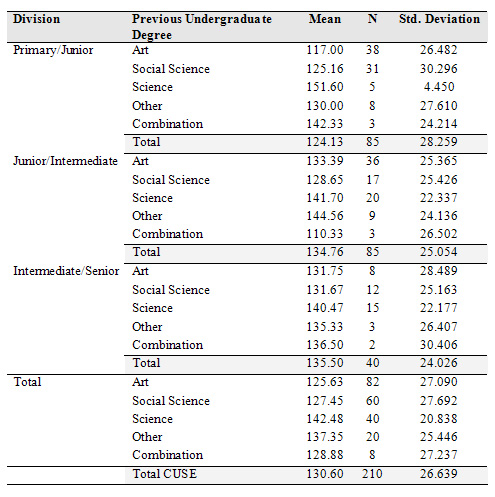
The study utilized a mixed method design by adapting the designs of Creswell’s (2003) concurrent nested strategy and Tashakkori and Teddlie’s (2003) multistrand concurrent mixed model design. The concurrent nested mixed-model design (see Figure 1) consisted of two strands of research with both types of questions, both types of data and analyses, and both types of inferences pulled together at the end to reach a meta-inference (Tashakkori & Teddlie). A nested approach contained the predominant method that guided the project (Creswell). The method with less priority (in this study, qualitative) was embedded or nested within the predominant method (in this case, the quantitative). One of the benefits of the mixed model research is that mixing could occur in many or all stages of the study. This model is required to meet a more rigid set of assumptions compared to mixed method research (Tashakkori & Teddlie, 1998). For instance, a mixed model might encompass multiple research questions, derived from different paradigms, mixed through a single research project (Greene & Caracelli, 1997). The strength of the concurrent nested-mixed model used in this study was that the researcher was able to collect two types of data simultaneously, during the single data collection phase. Furthermore, by engaging in a study with the capabilities of both qualitative and quantitative research methods, the researcher was able to gain perspectives from the different types of data and from different levels within the study (Creswell).
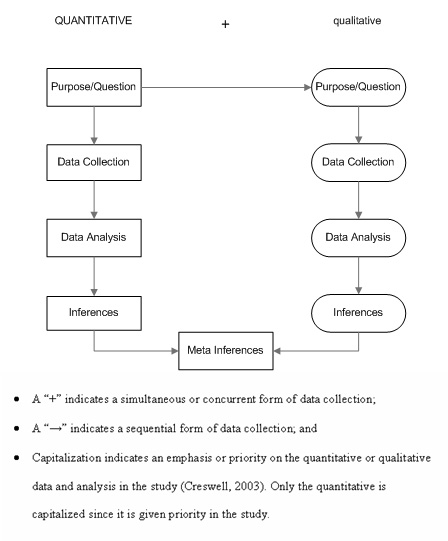
Figure 1: Concurrent Nested Mixed-Model Design
The quantitative component of study analyzed the CUSE scale in relationship to the following independent variables: gender, age, ethnic origin, previous undergraduate degree, licensure area, experience, computer software packages, computer ownership, computer training, and socio-economic status. In the qualitative component, a survey consisting of open-ended questions was used to explore computer self-efficacy results by examining preservice teachers’ past technological interaction experiences and beliefs based on the four sources of self-efficacy.
The original CUSE scale examined the relationship between self-efficacy, computer experience, use of software packages (i.e., familiarity), computer training, computer ownership and gender (Cassidy & Eachus, 2002). The 6-point Likert-type scale required that preservice teachers rate each statement from “strongly disagree” to “strongly agree”. In the original research (Cassidy & Eachus) this 30-item scale had a high internal consistency (Cronbach’s alpha = 0.97, N = 184) and high and significant test-retest reliability over a one-month period (r = 0.86, N =74, p<0.0005). In Part 1 of the study, Question #3 (ethnic origin), 4 (previous undergraduate degree), 5 (division), 10 (income level) were added to the original CUSE scale in order to achieve a clearer comparison between the three divisions (primary/junior, junior/intermediate, intermediate/senior) of preservice teachers.
Two previous studies that used the CUSE scale (Cassidy & Eachus, 2002; Wall, 2004) did not explore students’ past experiences from a qualitative perspective. Thus, the open-ended questions’ survey was used to explore computer self-efficacy results by examining preservice teachers’ past technological interaction experiences and beliefs based on the four sources of self-efficacy.
The responses to the CUSE scale and coded open-ended questions were analyzed using SPSS 14.0. One-way analysis of variance (ANOVA) was performed to test the hypotheses for statistical significance at the .05 level. If the hypothesis was statistically significant and the independent variable consisted of more than two levels, Tukey’s HSD (honestly significant difference) test for post-hoc comparisons was performed. In addition, a stepwise regression computation was done to exclude the independent variables that were not significant in predicting computer self-efficacy.
The qualitative responses of the survey were entered into a Word document. The coding of qualitative data was done after the researcher read through the document and assigned descriptive codes to participants’ words. The researcher often used participants’ own words. For instance, when a participant was asked about the worst problem they had with computers and they answered “virus infection” then that answer would receive the code “virus”. After codes were assigned to each question, each code was identified by a number and entered into SPSS. The goal of this procedure was to quantify the qualitative data. Therefore, the study explored emergent old and new themes by nesting the method.
The CUSE results indicated that the lowest score was 51 and the highest score was 176 out of a possible 180. The mean (M=130.60) and median (Mdn=133.0) values are close to each other, SD=26.639. A distribution was indicated by a majority of preservice teachers who had a moderately high degree of computer self-efficacy.
Table 2 gives the quantitative descriptive statistics of the study.One-factor between–subjects analysis of variance led to statistical significance of the variables indicated (see Table 2).
Table 2:ANOVA results
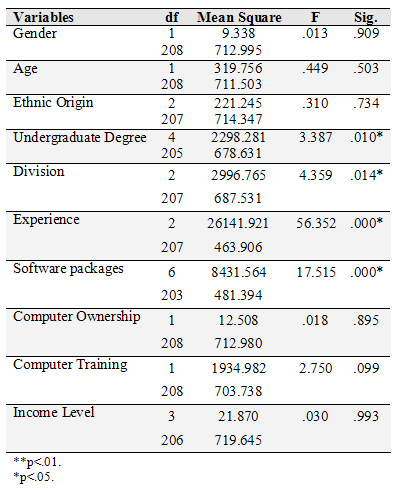
There was a significant difference in computer self-efficacy of preservice teachers based on their previous undergraduate degree. F (4,205) = 3.39, MSE = 678.631, p < .05. Post-hoc comparisons using the Tukey HSD test indicated a significant overall difference between Science and Art degrees and between Science and Social Science degrees, but no significant difference between any other variations of degrees. Eta squared for the scores was .062
There was a significant difference in computer self-efficacy of preservice teachers based on their licensure area. F (2,207) = 4.359, MSE = 687.531, p < .05. Tukey HSD indicated a significant overall difference between Primary/Junior and Junior/Intermediate groups, but no significant difference between any of the other divisions. Eta squared for the scores was .040.
There was a significant difference in computer self-efficacy of preservice teachers based on their computer experience. F (2,207) = 56.352 , MSE = 463.906 , p < .01. Tukey HSD indicated a significant overall difference between all three groups where eta squared for the scores was .353.
There was a significant difference in computer self-efficacy of preservice teachers based on their familiarity with software packages. F (6,203) = 17.515 , MSE = 481.394 , p < .01. Tukey HSD indicated a significant group difference with familiarity with software packages. Eta squared for the score was .341. No other hypotheses from the list above yielded a significant difference.
Stepwise regression
Table 3 shows detailed descriptions of seven variables that fulfilled the stepwise criteria . Table 4 gives a statistically significant result for the final model: F (7, 202) = 25.202, p<.01, where Table 5 indicates R²=.466 for all seven variables. The stepwise regression yielded the following equation (Table 6):
Y (Total Predicted CUSE) = 111.073 + 33.349 (Experience-3) - 25.100 (PACK01) - 25.104 (PACK2) -12.866 (PACK3) -10.466 (PACK4) + 8.736 (Degree-Science)
Table 3: Description of Stepwise Regression Variables
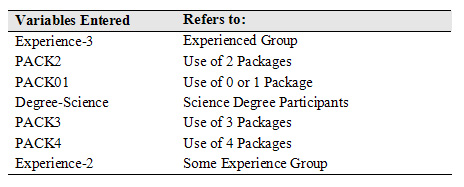
Table 4: ANOVA
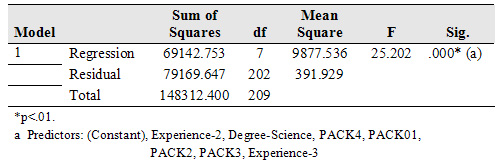
Table 5: Model Summary
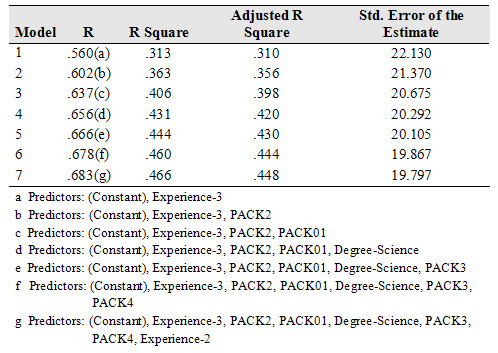
A stepwise regression computation was used to examine the relationship between independent variables that were significant in predicting computer self-efficacy. Forty-seven percent of the variation in the computer self-efficacy can be predicted from the use of 0 or 1, 2, 3 and 4 packages, science degree, some experience and experienced groups. Thus, these independent variables had a greater impact in predicting computer self-efficacy. A positive relationship was indicated between computer self-efficacy and the experienced (Experience-3) group (β=.620) and the science (Degree-Science) group (β=.129). The results show participants with “quite a lot” and “extensive” experience and a science degree tend to have higher self-efficacy.
Table 6: Final model for equation
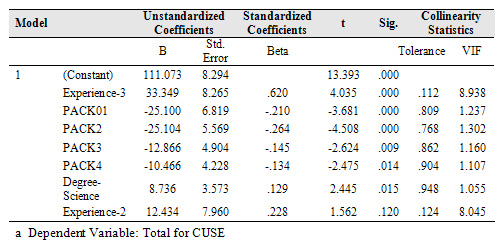
The highest positive beta values were achieved by the Experience-3 group (β=.620) and the Degree-Science group (β=.129) while PACK01 had the highest negative beta value (β= -0.210). A negative relationship was indicated between computer self-efficacy and use of packages with PACK01 (β=-.210), PACK2 (β=-.264), PACK3 (β=-.145) and PACK4 (β=-.134). The results show that preservice teachers who had used less than five packages (0,1,2,3, or 4) tended to have lower computer self-efficacy than those who had used five or more packages. Along the same line, the results further indicated that preservice teachers who had used less then three packages were the most negatively related to computer self-efficacy.
The preservice teachers described their previous computer experiences and beliefs based on the following four sources of self-efficacy (Figure 2 and Figure 3):
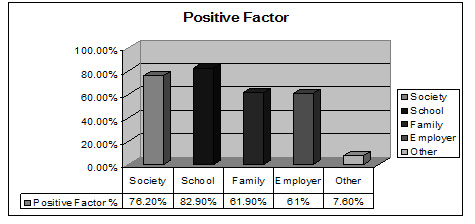
Figure 2: Positive Verbal Persuasions Factors Percentages
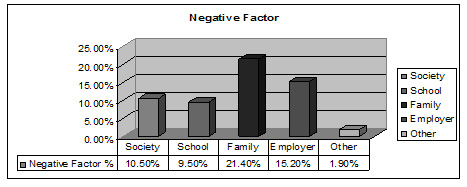
Figure 3: Negative Verbal Persuasions Factors Percentages
The purpose of this study was to determine if independent variables (gender, age, ethnic origin, previous undergraduate degree, licensure area, computer experience, use of software packages, computer training, computer ownership and socio-economic status) had a statistically significant impact on the dependent variable (computer self-efficacy of preservice teachers from the University of Windsor). In addition, open-ended questions enabled us to explore preservice teachers’ computer self-efficacy results by examining their past technological interaction experiences and beliefs based on the four sources of self-efficacy. The participants were surveyed at the beginning of the fall semester after they had experienced their first practice teaching placement. Key findings of the study led to the following conclusions and recommendations.
A key finding of this study is that the type of undergraduate degree obtained by preservice teachers was a factor in their computer self-efficacy status. Specifically, it was found that there was a significant difference between Science and Art students, and Science and Social Science students. In both these cases, the Science students’ computer self-efficacy scores were significantly higher than those of their Arts and Social Science counterparts. This finding suggests that there is need in teacher preparatory institutions to introduce some form of computer-usage boosting courses that would specifically benefit the Arts and Social Science preservice teachers. Such targeted courses would enable these students to not only catch up with their Science counterparts, but also shore up their computer self-efficacy and potentials for the effective integration of computer technology into their lessons when they start teaching. The need for these booster courses becomes more glaring when cognisance is taken of the fact that the majority of preservice teachers, especially at the P/J licensure area, have non-science (Arts and Social Science) degrees.
The type of licensure area that preservice teachers were enrolled in was one of the contributing factors to participants’ computer self-efficacy. It was found there was a significant difference between the Primary / Junior (P/J) and Junior / Intermediate (J/I) licensure areas, but not between any other groups. The P/J division had the lowest CUSE mean scores and the lowest number of Science degree students. The Intermediate / Senior (I/S) division had the highest mean of CUSE scores and the highest percentage of Science degree students. The J/I had a more balanced number of students for Art, Social Science and Science degrees, but this group contained the largest number of Science students that had high self-efficacy scores. This finding suggests that Science students should be encouraged to enrol in P/J licensure area, as this would strengthen computer usage in this important area that serves as the foundation years for young students. Further, there is a much higher need in teacher preparatory institutions to introduce some form of computer-usage boosting courses across Primary / Junior areas to ramp up computer usage with those who aim to teach elementary students.
Computer experience was one of the major factors in predicting computer self-efficacy scores of preservice teachers. It was found that there was a significant difference in computer self-efficacy between all three (inexperienced, some experience and experienced) groups. The experienced group, with extensive computer experience, achieved the CUSE highest scores compared to other groups. In addition, this group contributed to 31% of the variation in computer self-efficacy predicted from the scores.
The participants’ familiarity with software packages was based on the following choices: word processors, spreadsheets, databases, presentation software, statistics packages, desktop publishing, multimedia and other. Those who scored higher on familiarity with software packages also obtained higher computer self-efficacy scores. Thus, it can be concluded that experienced preservice teachers who were familiar with software packages are more prepared to integrate computer technology into the curriculum.
A majority of participants believed that computer programs were geared equally toward both females and males. Female preservice teachers in the Bauer’s (2000) study were of the opinion that men knew more about computer technology. A majority of participants in the current study did not hold the same view as Bauer’s (2000) participants. This finding is an encouraging development identified in the present study because it implies that female preservice teachers regard themselves as being at par with their male colleagues with regard to computer technology, and do not harbour any gender-imposed mental reservation about their ability to attain computer self-efficacy.
A concurrent or sequential mixed-model or method with equal dominance of qualitative and quantitative data would enrich future research on computer self-efficacy for preservice teachers. More specifically, follow-up interviews with preservice teachers would assist in obtaining more detailed data on the qualitative portion of a study of this nature. Future research needs to investigate the computer self-efficacy beliefs of preservice teachers at the end of their teacher education programs, thereby further exploring an issue that the present study investigated at the beginning of the preservice program. As Wall’s (2004) study suggested, teacher education programs should continue to improve the computer self-efficacy of preservice teachers by providing technology teaching and learning experiences that include the four sources of self-efficacy. Finally, more research into the instructional design, development and delivery of meaningful and engaging educational technology learning experiences for pre-service teachers to develop their computer skills, their self-efficacy and their teaching practices with technology is needed.
Bandura, A. (1977). Social learning theory. Englewood Cliffs, N.J.: Prentice Hall.
Bandura, A. (1986). Social foundations of thought and action. Englewood Cliffs, NJ: Prentice-Hall.
Bandura, A. (1997). Self-efficacy: The exercise of control. New York: W.H. Freeman.
Bauer, J. F. (2000, November). A technology gender divide: Perceived skill and frustration levels among female preservice teachers. Paper presented at the Annual Meeting of the Mid-South Educational Research Association, Bowling Green, KY. (Eric Document Reproduction Service No. ED 447137).
Cassidy, S., & Eachus, P. (2002). Developing the computer user self-efficacy (CUSE) scale: Investigating the relationship between computer self-efficacy, gender and experience with computers. Journal of Educational Computing Research, 26(2), 133-153.
Creswell, J. (2003). Research design: Qualitative, quantitative, and mixed methods approaches (2nd ed.). Thousand Oaks, CA: Sage Publications.
Greene, J. C., & Caracelli, V. J. (Eds.) (1997). Advances in mixed-method evaluation: The challenges and benefits of integrating diverse paradigms (New Directions for Evaluation, No. 74). San Francisco: Jossey-Bass.
Hardy, M. D. (2003). "It should have been stressed in all education classes": Preparing pre-service teachers to teach with technology. Report: Searcy, AR. (Eric Document Reproduction Service No. ED 478379).
Jacobsen, M., Clifford, P., & Friesen, S. (2002). Preparing teachers for technology integration: Creating a culture of inquiry in the context of use. Contemporary Issues in Technology & Teacher Education, 2(3), 363-388.
Parker, M. F. (1993, November). The use of technology by education majors. Paper presented at the Mid-South Educational Research Association. New Orleans, LA. (Eric Document Reproduction Service No. ED369743)
Pellegrino, J. W., & Altman, J. E. (1997). Information technology and teacher preparation: Some critical issues and illustrative solutions. Peabody Journal of Education, 72(1), 89-121.
Roblyer, M. (2003). Integrating educational technology into teaching (3rd ed.). Upper Saddle River, N.J: Merrill/Prentice Hall.
Tashakkori, A., & Teddlie, C. (1998). Mixed methodology: Combining qualitative and quantitative approaches. Thousand Oaks, CA: Sage.
Tashakkori, A., & Teddlie, C. (2003). Handbook of mixed methods in social behavioral research. Thousand Oaks, CA: Sage.
Wall, A. (2004). An evaluation of the computer self-efficacy of preservice teachers. Unpublished doctoral dissertation. Tennessee State University. Nashville, Tennessee.
© Canadian Journal of Learning and Technology